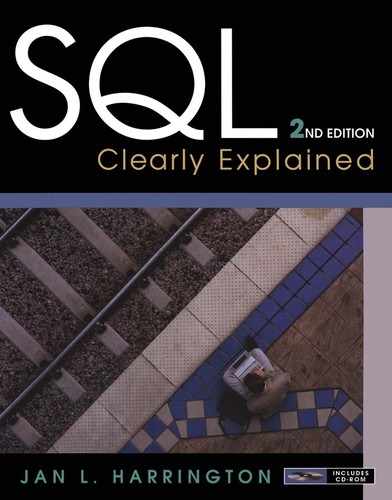Index
A
Abstract data types
372Access rights
265–271Accessors
374ALLOCATE DESCRIPTOR
328ALTER TABLE
255–259ANY
127Application classes
372Arithmetic
143–147Arithmetic operators
145ARRAY data type
404–406Assertions
233–234AVG
166C
CALL
300Catalogs
211–213CENTURY
153–154Character data types
221CHECK clauses
233–234Classes
abstract
381application
372container
374control
372entity
373inheritance
376–382interface
373methods
373–375object-relational
398–399user-defined data types as
410CLOSE
317Clusters
211–213COMMIT
282Common table expressions (CTEs)
244–248Composition
382–384Concatenation
147–148CONNECT
278–278Container classes
374Constraint checking
234–236Constructors
374Control classes
372Correlated subqueries
seeSubqueries
Correlation names
117–121COUNT
163–164CREATE ASSERTION
234CREATE DOMAIN
216–217CREATE FUNCTION
289CREATE INDEX
248–250CREATE PROCEDURE
288CREATE SCHEMA
215CREATE TABLE
218–234CREATE TEMPORARY TABLE
243CREATE TRIGGER
299–300CREATE USER
263–265CREATE VIEW
238–239CUME_DIST
191CURRENT_DATE
151–152CURRENT_TIME
151–152CURRENT_TIMESTAMP
151–152D
Date and time data types
221–222Data modification
changing data values
201–202copying rows from another table
199–200deleting rows
202–208embedded
317–322inserting one row
197–199with cursors
321–322Data retrieval
seeSELECT
DAY
153–154DBMS return codes
305–308DEALLOCATE DESCRIPTOR
334DECADE
153–154Decimal data types
219–220DECLARE CURSOR
311DECLARE SECTION
304–305Default values
223DEREF
413DESCRIBE
226DESCRIBE INPUT
330DESCRIBE OUTPUT
330Destructors
374DISCONNECT
279Divide (relational algebra)
61–63DROP DOMAIN
260–261DROP INDEX
260–261DROP MODULE
290DROP ROUTINE
290DROP TABLE
260–261DROP TRIGGER
300DROP VIEW
260–261E
Element names
213–214Embedded SQL
cursors
309–317data modification
317–322EXEC SQL
304fetching rows
314–314host language variables
304–305MATCH predicate
320return codes
305–308Embedded SQL
see alsoDynamic SQL
Entities
4Entity classes
373Equi-join
40–49EXCEPT
140EXEC SQL
303EXECUTE IMMEDIATE
323–326EXISTS
141–142EXTRACT
156F
FETCH
314–317Four-valued logic
104–105Functions
see alsoProgramming
Functions
see alsoSet functions
Functions
see alsoWindowing
Functions
see alsoXML functions
I
IF
293–294IN
95Information engineering
6Integer data types
219Interface classes
373Intersect (relational algebra)
59–61INTERSECT (SQL command)
142–143IS NULL
95–96Isolation levels
277Iteration
295–287J
JAVA
303JDBC
303M
Many-to-many relationships
13–15MATCH
320–321MAX
166MERGE
204–208MICROSECONDS
153–154MILLENNIUM
153–154MILLISECONDS
153–154MIN
166MINUTE
153–154Modifying data
Modifying table structure
seeTables
Modules
290Modules
see alsoProgramming
MONTH
153–154Multiple inheritance
381MULTISET data type
406–409Mutators
375N
Naming SQL elements
213–214NATURAL JOIN
seeJOIN
Negative queries
136–140NOT
88–90NOT BETWEEN
99–101NOT IN
136–139NOT NULL
223NTILE
191=4O
Object-oriented databases
390Object-oriented paradigm
benefits of
384classes
371–384composition
382–384inheritance
376–382method types
374–375objects
367–371overloading
375–376polymorphism
318–382versus relational data model
384–389Object-relational data model
data structures in
398classes in
398–399entity-relationship diagrams for
392–397relations
398Object-relational SQL
ARRAY data type
404–406inheritance
412–413methods
414–416MULTISET data type
406–409REF data type
412–414ROW data type
402–403typed tables
410–411UDTs as classes
410UDTs as domains
409One-to-many relationships
11–13One-to-one relationships
10–11OPEN
314Operators
+ (addition)
145AND
88–90ANY
127BETWEEN
99–101CASE
157–159CAST
167–169‖ (concatenation)
147–148/ (division)
145= (equal to)
86–88EXISTS
140–142EXTRACT
156HAVING
175–177IN
95IS NULL
95–96< (less than)
86–88<= (less than or equal to)
86–88> (greater than)
86–88>= (greater than or equal to)
86–88LIKE
93–94* (multiplication)
145NOT
88–90NOT IN
131–136NOT BETWEEN
99–101!= (not equal to)
86–88< > (not equal to)
86–88OR
88–90OVERLAPS
155precedence of
146–147– (subtraction)
145– (unary minus)
145+ (unary plus)
145OVERLAPS
155Overloading
375–376P
Parameter passing
291–292Partitions
179–184PERCENT_RANK
189PERCENTILE_CONT
194–196PERCENTILE_DISC
194–196Polymorphism
381–382Precedence
146–147Predicates
seeWHERE clause
PREPARE
330Procedures
289–290Procedures
see alsoProgramming
Product (relational algebra)
42–45Programming
assignment
290–291creating functions
289creating modules
290creating procedures
288deleting modules
288executing modules
298–300iteration
295–297LOOP
295–296parameter passing
291–292REPEAT
296scope of variables
292SQL DECLARE SECTION
292variables
290–292WHILE
296Programming
see alsoEmbedded SQL
Q
QUARTER
153–154R
RANK
184–187Recursion
244–248REF data type
412–414Relational algebra
definition
29–30difference
58–59divide
61–63intersect
59–61join
39–59outer join
50–54product
42–45union
37–38Relational calculus
29Relational data model
columns
5–6domains
7foreign keys
16–18history of
4nulls
9–10primary keys
7–9referential integrity
16–18repeating groups
4–5rows
5–6versus object-oriented data model
382–389Relationally complete
29Relationship operators
88–86Renaming table elements
258REPEAT
296–297Retrieval
seeSELECT
Return codes
305–308REVOKE
269–270Roles
270–271ROLL BACK
282ROW data type
402–403ROW_NUMBER
189Routines
seeProgramming
S
SECOND
153–154SELECT (SQL command)
arithmetic
143–147CASE expressions
157–159changing data types with CAST
167–169choosing columns
77–80choosing rows
84–101common table expressions (CTEs) for
244–248correlated subqueries
140–142GROUP BY
170–175HAVING
175–177joining tables
107–125negative queries
131–140removing duplicate rows
80–82sorting rows
82–84uncorrelated subqueries
125–130Select (relational algebra)
seeRestrict
SET DESCRIPTOR
330–331SET SCHEMA
215–216SET TRANSACTION
278SQL
see alsonames of individual commands
SQL DECLARE SECTION
292SQL programming
seeProgramming
SQL/XML
seeXML
SQLSTATE
305–308START TRANSACTION
281–282String data types
221SUBSTRING
149–150SUM
164–165T
Table constructors
124Tables
adding columns
256adding constraints
256assertions
233–234CHECK clauses
233–234constraint checking
234–236creating
218–234data types for
219–222default values
223deleting elements
258foreign keys
223–233modifying structure of
255–259NOT NULL constraints
223primary keys
223renaming elements
259typed
410–411unique values
233Tables
see alsoRelations
Tables
see alsoTemporary tables
Theta join
49–50Three-valued logic
103–104Time manipulation
Triggers
298–300TRIM
149TRUNCATE
205Typed tables
410–411U
Uncorrelated subqueries
seeSubqueries
Union (relational algebra)
37–38UNION (SQL command)
131–136Unique column values
233UPPER
148–149User-defined data types (UDTs)
SQL
V
Views
creating
238–239definition
18deleting
260–261reasons for using
237–238retrieval using
239–240updating data using
240–241Virtual tables
10W
Well-formed XML
344–346WHERE clause
complex predicates for
97–98joins
107–125logical operators for
88–90negation
90–91nulls
103–105operator prececdence
91–92primary key expressions
96–97relationship operators for
86–88set functions in
167simple predicates for
97table constructors
124uncorrelated subqueries
125–130WHILE
296Window functions
seeWindowing
X
Y
YEAR
153–154..................Content has been hidden....................
You can't read the all page of ebook, please click here login for view all page.
